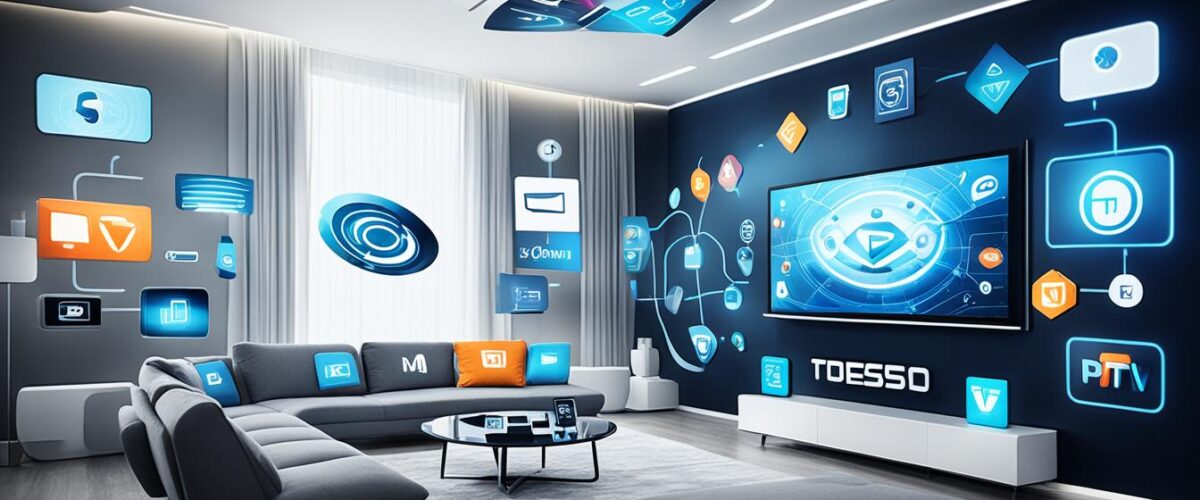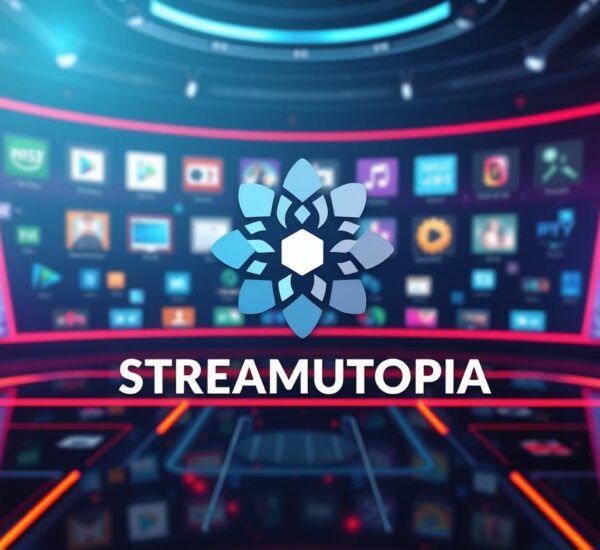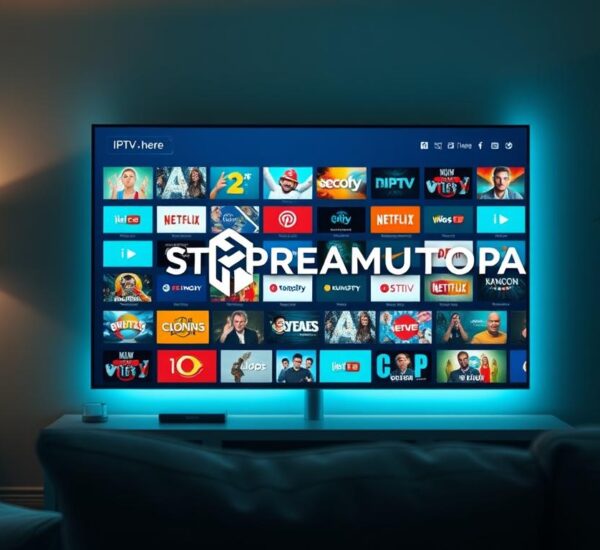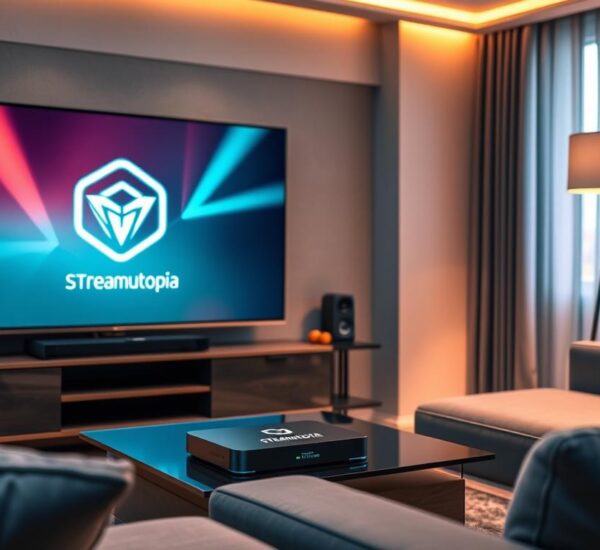Have you ever thought about why traditional TV seems to be losing viewers in our tech-filled world? Internet Protocol Television (IPTV) is leading the change, changing how we watch shows. Since the late 1990s, IPTV has grown thanks to fast internet, letting us stream high-quality videos1. It’s different from old cable and satellite TV because it offers personalized options. This makes it more accessible and fun than ever.
Platforms like StreamUtopia are at the forefront of this change. They offer high-definition streaming, lots of content, and 24/7 support. This shows that IPTV is indeed the future of TV.
Key Takeaways
- IPTV is reshaping the landscape of television.
- It provides cost-effective subscription plans compared to traditional services2.
- High-definition and 4K streaming is becoming widely available2.
- Adaptive Bitrate Streaming enhances user experience by adjusting video quality in real-time1.
- The future may see IPTV integrating AI and virtual reality for personalized experiences21.
Introduction to IPTV
IPTV, or Internet Protocol Television, is changing how we watch our favorite shows. It uses the internet to send shows directly to viewers, unlike old TV ways. This shift marks a new era in television, with IPTV at the forefront3.
It started in 1995, aiming to send video over IP networks4. The 2000s brought new tech that made IPTV popular. Now, it lets viewers watch shows when they want, making TV more personal.
IPTV is known for its high quality, with little to no packet loss3. You can pick from many plans, starting at $19.99, offering thousands of channels worldwide. Whether it’s live sports or the latest news, IPTV has something for everyone.
What is IPTV?
IPTV, or Internet Protocol Television, is a new way to watch TV over the internet. It uses a packet-switched network, unlike old cable or satellite TV. This lets viewers watch TV without the usual limits, giving them more control over what they watch5.
Back in the early 1990s, broadband technology changed everything. It led to the rise of IPTV in the late 1990s and early 2000s. Now, people can watch live TV, movies, and videos on devices like TVs, smartphones, and tablets5.
The IPTV definition shows it’s more than just TV. It lets users watch many channels at once, with features like Video On Demand (VOD) and live streaming. This suits today’s viewing habits, letting users watch their favorite shows anytime, anywhere, on any device. It’s a big change from traditional cable, making watching TV more engaging and fun.
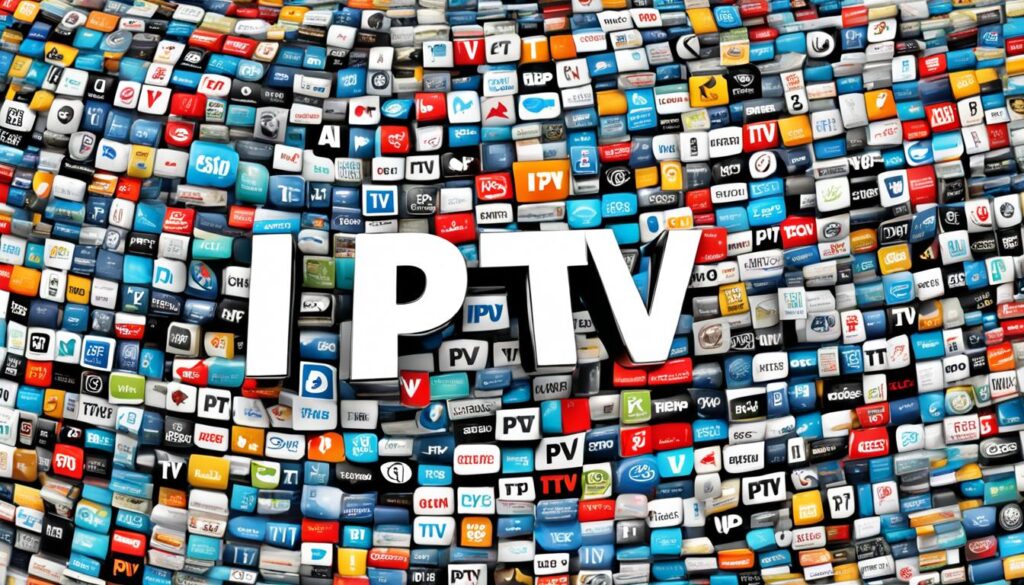
With IPTV, several TVs in a home can share one subscription, making it a great value. This approach gives viewers a customized experience. It shows how the entertainment industry is evolving, with more people seeking reliable streaming services. Experts believe IPTV will grow a lot, with its value doubling by 2029, showing its growing popularity6.
How IPTV Works
IPTV works by using two key parts: content acquisition and streaming technology. These are vital for delivering top-notch media services to viewers.
Content Acquisition and Encoding
Content acquisition in IPTV means getting video programs and on-demand content from different sources. This gives viewers a wide range of choices. After getting the content, it gets encoded. This uses tech like H.264 to make it smaller without losing quality. By 2024, 72% of all internet traffic will be from IPTV and online videos7.
Marriott Hotels use IPTV in over 300 locations. This shows how IPTV improves both the viewer’s experience and how the hotel works7.
Streaming Technology
Streaming technology in IPTV sends content over the internet. This lets viewers watch without interruptions, thanks to adaptive bitrate streaming. It changes the quality based on how fast the internet is.
Companies like IPTV because it’s flexible, scalable, and interactive. It uses the internet to save money7 and8. IPTV is not just for fun. It’s also used for training and teaching in businesses7.
Benefits of IPTV
IPTV offers many advantages over traditional TV. It uses advanced technology for a more personalized viewing experience. Users can tailor their profiles to match their interests, making it easier to find shows they like. This personalized TV experience gets even better with AI-driven recommendations9.
Personalization and User Control
There are many subscription plans to choose from, covering sports, movies, and documentaries. This is a big change from old cable TV9. IPTV lets viewers watch on-demand content and control playback with pause, rewind, and fast-forward. This makes for a more engaging personalized TV experience in today’s digital world.
High-Quality Streaming Experience
One key benefit of IPTV is its ability to stream high-definition content with great picture and sound quality9. It offers access to many channels worldwide and works on devices like smartphones, tablets, and computers. This flexibility is important for viewers who want to watch TV on their terms10.
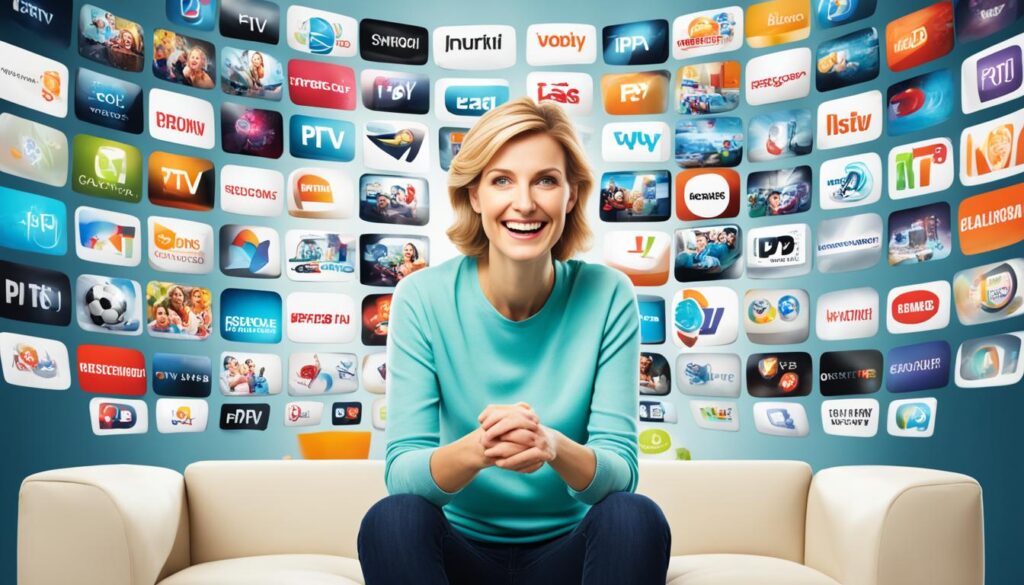
| Feature | IPTV | Traditional TV |
|---|---|---|
| Channel Variety | Extensive global options | Limited channel access |
| On-Demand Content | Wide library available | Minimal availability |
| Device Accessibility | Multi-device streaming | Primarily TV-based |
| Picture Quality | High definition | Standard definition |
| Playback Control | Pause, rewind, and fast-forward | Fixed broadcast schedule |
IPTV meets the needs of today’s viewers by offering a flexible, high-quality streaming experience. It provides IPTV benefits that match their preferences and needs.
Why IPTV Is the Future of Television
IPTV is quickly becoming the next big thing in TV. More and more people want to watch TV shows and movies on their own terms. This has made IPTV services very popular11. Fast internet lets you stream without waiting, making IPTV even more appealing11. You can also pick just the channels you want, saving money compared to traditional TV11.
IPTV has a lot to offer, like a huge selection of movies and series for all tastes12. It lets you watch on different devices, making it super convenient12. Plus, it works well with smart home tech, making it easy to control with your voice or phone11.
Being able to pause, rewind, and record live TV makes watching TV more fun11. Some IPTV services even create their own shows, setting them apart in a crowded market1112. As people want more control over what they watch, IPTV is becoming the top choice for entertainment.
| IPTV Features | Traditional TV |
|---|---|
| On-Demand Content Access | Limited Access |
| Custom Channel Packages | Fixed Packages |
| Multi-Device Support | Single Device |
| Interactive Features | Minimal Interaction |
| Flexible Pricing | Contractual Obligations |
Comparing IPTV with Traditional TV Providers
Television viewing has changed a lot, especially with IPTV coming along. IPTV is different from traditional TV like cable or satellite. It uses the Internet to send shows, which is more flexible and lets viewers watch what they want when they want it. This is unlike traditional TV, which has set schedules.
IPTV is all about making things easy for the viewer. It streams in high-definition, so shows look great even if your internet is slow. You can also pause, rewind, and watch shows on your own time, which isn’t always possible with traditional TV1314. Plus, IPTV lets you change or cancel your subscription anytime without extra fees13. Traditional TV often makes you sign up for a year or more.
Looking at costs, IPTV is a good deal. It combines TV, internet, and phone into one package, making bills easier to manage and saving money14. Sure, it might cost a bit more than some streaming services. But it offers better reliability and more channels, including ones from around the world13.
IPTV’s user-friendly features make watching TV better. It has smart search and recommendations that make finding shows easy and fun13. These features make IPTV a great choice for viewers who want control and ease. In short, IPTV is becoming a top choice for those looking for something new in TV watching.
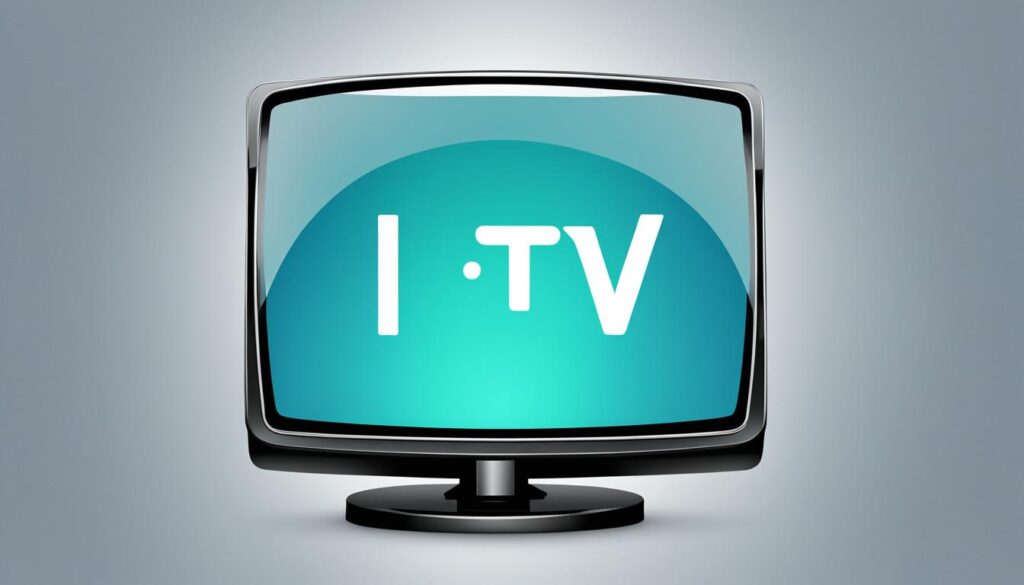
IPTV Technology: Behind the Scenes
IPTV technology uses complex protocols and video compression to make watching TV smooth. It uses IGMP for channel signaling and RTSP for video on demand. These protocols help users get content quickly and efficiently, making switching between channels easy.
Protocols and Standards
IGMP is key to delivering live TV efficiently. It helps send multicast streams in real-time. RTSP manages multimedia data, setting up and controlling media sessions. Together, these technologies let providers offer a wide range of content that users like.
Video Compression Techniques
Video compression is crucial for IPTV, as it needs to deliver quality video without using too much bandwidth. H.264 and MPEG-2 are widely used, making videos smaller without losing quality. This is important as it lets users enjoy high-quality content without slow streaming.
Using IPTV protocols and video compression together makes watching TV better for users. As IPTV grows, it meets viewer needs by offering more flexibility and customization. It’s becoming a big part of how people watch TV, thanks to new apps and streaming tech.
For a step-by-step guide on installing an IPTV player on an Amazon Fire TV Stick, check out this guide1516.
IPTV Trends and Growth Outlook
The IPTV market is changing fast, growing because more people want to watch shows and movies on their own time. It’s now worth USD 68.78 billion and could reach USD 276.38 billion by 2032, growing at 16.8% a year17. This growth is thanks to people wanting shows they like and more devices that let them watch IPTV easily. More people are choosing streaming over traditional TV, making IPTV a big deal18.
Market Trends in Streaming Services
The IPTV market will grow by USD 128.40 billion from 2023 to 2028, showing how fast streaming is changing19. North America, especially the U.S., is a big part of this growth because of many service providers and a desire for quality shows19. Working with big names like Netflix and Amazon Prime Video also helps IPTV grow17.
Consumer Demand for On-Demand Content
More people want to watch shows and movies when they want, which is good for IPTV18. Right now, the hardware part of IPTV is the biggest, but software is growing faster17. With better internet from 5G, IPTV will get even more popular, making top-notch content easy to get17. This means more users and more competition as IPTV keeps changing.
The Role of Artificial Intelligence in IPTV
Artificial Intelligence is changing IPTV, making it better for users. AI helps make IPTV more personal and picks content just for you. For example, AI can make viewers watch more by suggesting shows they like20. It also helps keep viewers coming back by understanding what they watch20.
AI makes finding shows easier and faster, making users happier. It cuts the time to find shows by 25% and boosts satisfaction by 30%20. Plus, AI reduces buffering by 40%, making streaming smoother20.
AI also helps with running things smoothly, like planning schedules and making ads more effective. It can create channels that match what viewers like, helping ads reach more people21. Dynamic ads, powered by AI, can increase sales by 50%20.
AI also improves how videos look and costs less, making watching shows better. It keeps live channels clear at lower quality settings21. Plus, AI fights piracy by quickly spotting illegal streams21.
IPTV and 5G: Enhancing User Experience
The mix of IPTV and 5G is changing how we watch streaming content. 5G technology offers speeds up to a few Gbps, much faster than the average 4G speed of 10 MB/s. It gives an average speed of 50 MB/s22. This means users can easily watch HD and even 4K content without any hassle.
5G supports data transfer rates between 1-10 GB/s, unlike 4G’s 1 GB/s23. With over 30% of mobile users moving to 5G by 2025, the need for high-quality IPTV will grow a lot22.
In the United States, 5G is helping IPTV users by fixing latency issues, making streaming smooth. This means users get more flexibility and a wider range of content, making IPTV more appealing23. The global IPTV market is expected to grow a lot, reaching USD 194.21 billion by 2028. This growth is thanks to 5G technology and more people wanting it24.
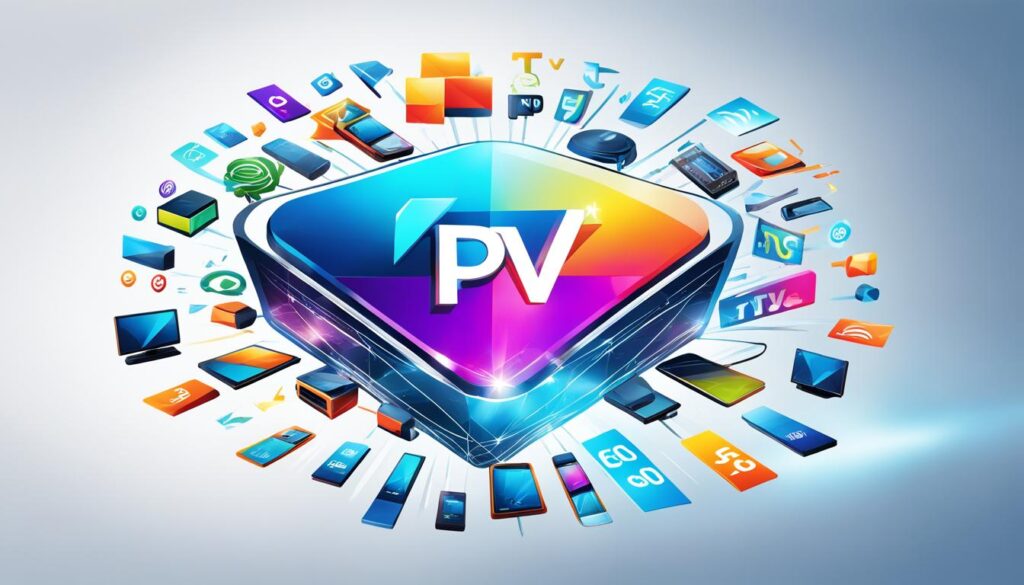
This partnership between IPTV and 5G is making watching content better and changing digital entertainment. With the world’s population set to hit 11.2 billion by 2100, reliable, fast Internet like 5G will be key22. 5G is making IPTV services better, offering fast wireless Internet access. This is starting a new era of entertainment.
Case Studies: Successful IPTV Providers
StreamUtopia.com is a great example of how IPTV providers can succeed. It offers different subscription packages to fit what users want to watch. This focus on quality and user happiness has made StreamUtopia stand out in the IPTV market.
StreamUtopia Overview
StreamUtopia is known for its wide range of entertainment options. It’s affordable and flexible, making it a great choice for those looking to leave traditional cable TV behind. More people are choosing IPTV services like StreamUtopia, Netflix, and Amazon because they’re cheaper. These platforms offer subscriptions for under $10 a month25.
| Provider | Monthly Cost | Content Variety | User Satisfaction |
|---|---|---|---|
| StreamUtopia | Under $10 | Diverse options | High |
| Netflix | Under $10 | Original shows, Movies | High |
| Amazon Prime Video | Under $10 | Widespread selections | High |
Fast internet is making IPTV more popular. With free internet in many areas, more people are choosing online TV. Shows like “Orange is the New Black” have helped IPTV services like StreamUtopia grow26.
Challenges Facing IPTV
The IPTV industry is growing fast because it offers many benefits over traditional TV services. Yet, it faces challenges that stop some people from using it. For example, not everyone has fast internet, especially in rural areas27. This makes it hard for them to watch shows without buffering.
Legal problems are also a big deal in IPTV. Some services share illegal content, so users must be careful to pick legal ones27. Also, some channels can’t be watched in certain places because of licensing issues28.
How well IPTV works depends on its Content Delivery Network (CDN). With more people wanting high-quality streams, the network must be strong. It’s also important to keep the service safe from hackers and pirates28.
As IPTV grows, solving these problems is key to its success. New technology and infrastructure could help make IPTV better for everyone29.
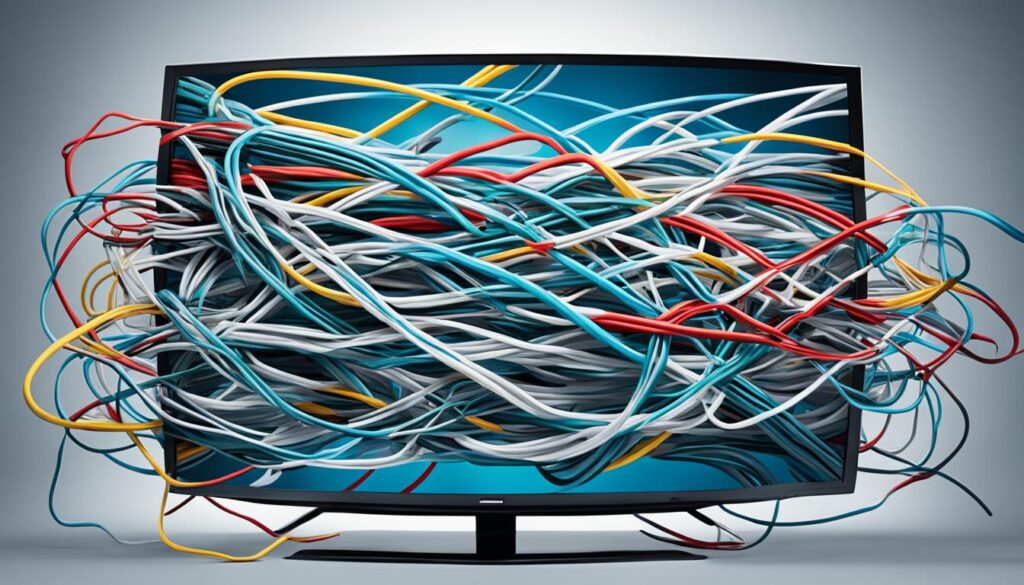
| Challenges | Description | Impact on Users |
|---|---|---|
| High-Speed Internet Access | Limited access in rural areas restricts service quality. | Poor streaming experience, reduced engagement. |
| Legal Issues | Pirated content offerings pose legal risks for consumers. | Users must be cautious to avoid legal trouble. |
| Content Licensing | Restrictions based on geographic location. | Limited access to certain channels and content. |
| Network Performance | Reliability of the CDN affects streaming quality. | Potential for buffering and interruptions. |
| Security Risks | Threat of unauthorized access and piracy. | Consumer trust may be compromised. |
Innovative Features of IPTV
IPTV is changing how we watch TV with its new features. It lets users interact with shows through real-time polls and quizzes. This makes watching TV more fun and engaging30. People using IPTV watch TV 30% more than those with traditional cable, showing how engaging it is30. Over 70% of users like watching shows on demand, which is key for today’s viewers30.
Interactive Applications and User Engagement
Interactive apps in IPTV make watching TV more fun and personal. AI and machine learning help suggest shows based on what you like31. Services like Eternal IPTV offer more channels and special content, making it more accessible31. These features create a community feel, letting viewers interact through live polls and activities.
On-Demand Content Access
IPTV lets you watch shows whenever you want, unlike traditional TV. It has a huge library of content, making it easy to find something you like30. Experts predict IPTV will be worth over $67 billion by 2025, thanks to the popularity of high-definition shows30. With over 10,000 channels, you can easily find your favorite shows30.
The Future of TV Viewing: IPTV’s Promising Landscape
The future of TV is closely linked with IPTV technology’s growth. IPTV offers many channels and on-demand content, meeting different viewer tastes. It includes international shows that traditional TV often misses32. This change promises a bright future for IPTV, making TV more interactive and engaging.
IPTV is becoming more popular because it’s affordable. It lets viewers pay only for what they watch, without long-term contracts32. Now, video content makes up almost 82% of internet traffic worldwide, showing IPTV’s importance33. IPTV uses special methods and bandwidth for videos, giving better image and sound quality33.
Next-generation tech like 5G will make IPTV even better, improving streaming quality and reliability34. As IPTV takes over traditional TV, it offers personalized content based on what viewers like. This suits the growing need for customized content in today’s media world34.
Convergence of IPTV and Other Technologies
The mix of IPTV and technology is changing how we watch media. This blend, especially with augmented reality (AR) and virtual reality (VR), brings new ways to feel connected to what we watch. Now, viewers can pick from many live channels, on-demand shows, and special streaming services worldwide35. With 5G technology coming, streaming will be smoother and faster, making it easier to watch shows in real-time36.
Features like video-on-demand, watching shows at any time, and watching on different devices make IPTV popular35. It lets viewers get content that fits their likes and even watch shows from different angles36. As IPTV keeps getting better, we’ll see even more ways to watch TV on our devices without interruptions37.
As IPTV grows, we need to worry about copyright issues, keeping data safe, and security. But, the future looks bright with new tech changing how we make and watch shows36. The mix of IPTV and new tech could change how creators and viewers connect worldwide37.
Conclusion
IPTV is changing the way we watch TV. It offers features like Video on Demand (VoD) and easy-to-use interfaces. These make it a top choice for viewers38. It also lets you watch high-quality shows and movies on various devices, making it a leading option for the future39.
Even with challenges like managing infrastructure and keeping quality high during busy times, IPTV is getting better. With more innovation and reliable technology, it will keep winning over traditional TV38. The future looks bright for IPTV, thanks to its convenience, interactivity, and personalized viewing options38.
IPTV is combining with broadband and mobile tech to reach more people. This means it will change how we watch TV and set new standards for what we expect. IPTV is set to play a key role in this change, making it a big part of the future of TV39.
FAQ
What are the primary advantages of using IPTV over traditional cable or satellite services?
How does IPTV technology work?
Will IPTV continue to grow in the future?
What role does artificial intelligence play in enhancing IPTV?
Are there any challenges associated with IPTV?
How does IPTV compare to other streaming services?
What innovations are transforming the IPTV experience?
Source Links
- What is IPTV? A Deep Dive into its History, Technology, and Future – Amira Labs – https://amiralabs.com/articles/what-is-iptv-a-deep-dive-into-its-history-technology-and-future
- Why is IPTV the Future of Television? – https://www.mid-day.com/tech/tech-news/article/why-is-iptv-the-future-of-television-23360266
- What is IPTV and How Does it Work? – https://blog.servermania.com/what-is-iptv
- What is IPTV (Internet Protocol Television) & How Does It Work? – https://www.firesticktricks.com/what-is-iptv.html
- What is IPTV? How IPTV works? Best IPTV Devices, Services, and more! – https://www.muvi.com/blogs/what-is-iptv-how-iptv-works/
- What is IPTV? Understanding the Ongoing Revolution in Digital Media – https://www.uscreen.tv/blog/what-is-iptv/
- Internet Protocol Television (IPTV)—How It Works and Why It’s Critical for Business in 2024 – https://suncomm.tv/internet-protocol-television-iptv-how-it-works-and-why-its-critical-for-business-in-2024/
- What Is IPTV: How It Works, Types, Pros, & More – https://www.redswitches.com/blog/what-is-iptv/
- Exploring the Benefits of IPTV for TV: A Comprehensive Overview – https://www.ask.com/entertainment/exploring-benefits-iptv-tv-comprehensive-overview
- IPTV Meets Digital Signage: Benefits, Uses & Applications – https://onediversified.com/insights/blog/iptv-digital-signage
- Exploring the Future of IPTV Services – https://www.hr.com/en/resources/wikis/exploring-the-future-of-iptv-services_lhjnzv6t.html
- The Future of Television: Saying Goodbye to Cable with IPTV – https://medium.com/@XtreamOnline/the-future-of-television-saying-goodbye-to-cable-with-iptv-9ab26c2e44b3
- Why IPTV Is Superior to Traditional Cable Television – Infomir USA/Canada Retail Shop – https://us.infomir.store/why-iptv-is-superior-to-traditional-cable-television/
- IPTV vs OTT: Key Differences and Choosing the Right Option – https://www.enveu.com/blog/iptv-vs-ott/
- Internet Protocol television – https://en.wikipedia.org/wiki/Internet_Protocol_television
- All You Need to Know About IPTV: A Comprehensive Guide – https://getmaxtv.com/all-you-need-to-know-about-iptv-a-comprehensive-guide/
- IPTV Market Size, Share, Growth, Forecast | Global Report 2032 – https://www.fortunebusinessinsights.com/internet-protocol-television-iptv-market-106645
- IPTV Industry Insights 2024-2032: Trends, Challenges, and Growth Opportunities – https://www.linkedin.com/pulse/iptv-industry-insights-2024-2032-trends-uazwf
- Global Internet Protocol Television (IPTV) Market — Industry Trends and Forecast to 2024–2028 – https://medium.com/@infinitiinfiniti082/global-internet-protocol-television-iptv-market-industry-trends-and-forecast-to-2024-2028-f0fc6946a3cb
- The Role of AI in Revolutionizing IPTV Services – AI Toronto – https://ai-toronto.com/the-role-of-ai-in-revolutionizing-iptv-services/
- How Artificial Intelligence is Transforming the Video Streaming Industry – https://www.harmonicinc.com/insights/blog/ai-video-streaming/
- How 5G networks can transform IPTV/OTT | Infomir Blog – https://www.infomir.eu/eng/blog/articles/34-how-5g-transform-iptv/
- What is IPTV? Discover the Ultimate Guide to Modern TV Streaming – BlueAngelHost – Official Blog – https://www.blueangel.host/blog/what-is-iptv/
- The IPTV Industry- Market Size, Trends, and Future Opportunities – https://www.linkedin.com/pulse/iptv-industry-market-size-trends-future-yogita-sharma-gnvmf
- 5 Reasons To Adopt IPTV Today Over Traditional TV – Muvi One – https://www.muvi.com/blogs/5-reasons-to-adopt-iptv-today-over-traditional-tv/
- 6 Reasons Why IPTV is the Future of Television – https://testarea.tikilive.com/tiki-blog/iptv-category/6-reasons-why-iptv-is-the-future-of-television/
- IPTV Service: The Future of Television or a Passing Fad? – https://medium.com/@cimopa7853/iptv-service-the-future-of-television-or-a-passing-fad-c4fdc14af411
- The Evolution of Television: A Comprehensive Guide to IPTV – Touch of Europe – https://touchofeurope.net/the-evolution-of-television-a-comprehensive-guide-to-iptv/
- IPTV: challenges and future directions – Multimedia Tools and Applications – https://link.springer.com/article/10.1007/s11042-010-0617-9
- IPTV (2024): The Ultimate Guide to Revolutionizing Your Television Experience – https://sndcbroadband.com/iptv/
- Unveiling the Future of TV- Eternal IPTV Trends in 2024.pdf – https://www.slideshare.net/slideshow/unveiling-the-future-of-tv-eternal-iptv-trends-in-2024-pdf/269806164
- Understanding IPTV: The Future of Television – https://medium.com/@shubhamkumarsingh19397/understanding-iptv-the-future-of-television-12c8d03a520b
- IPTV vs. OTT – Internet TV Explained – https://corp.kaltura.com/blog/iptv-ott/
- IPTV: The Ultimate Platform for On-Demand and Live Streaming – https://www.linkedin.com/pulse/iptv-ultimate-platform-on-demand-live-streaming-perfectmedia-k1nwc
- The Next Frontier of Television: Unraveling the Intricacies of IPTV – https://www.linkedin.com/pulse/next-frontier-television-unraveling-intricacies-iptv-usman-ali-mtnzf
- The Future of IPTV: Revolutionizing the Way We Consume Television – https://medium.com/@mandarinpusal_23032/the-future-of-iptv-revolutionizing-the-way-we-consume-television-f4e99605a0a3
- IPTV: The Future of Television? – https://www.wired.com/2006/03/iptvthefutureoftelevision/
- Exploring IPTV Providers: The Future of Television – https://www.linkedin.com/pulse/exploring-iptv-providers-future-television-md-shahin-qaunc
- Microsoft Word – IPTVrapport.doc – https://citeseerx.ist.psu.edu/document?repid=rep1&type=pdf&doi=719f0255392eaf01d53295453c30a2579bcbf5ad
